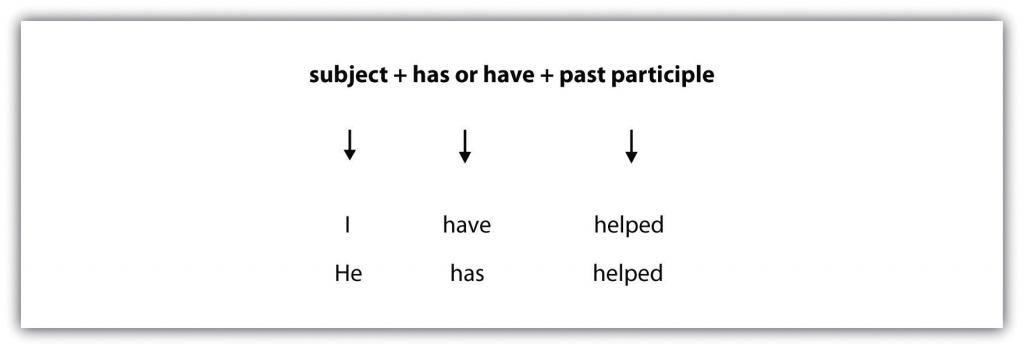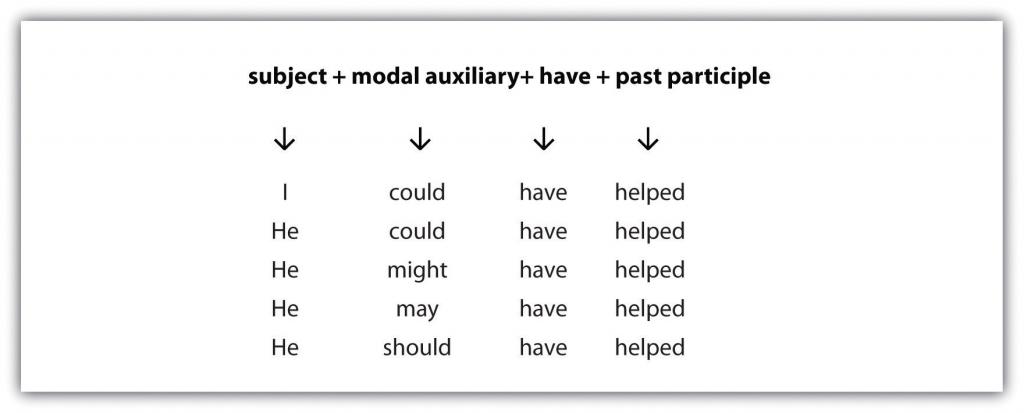10.5 – Modal Auxiliaries
Learning Objectives
- Demonstrate an understanding of sentence structure fundamentals, grammatical clarity, and mechanical correctness.
- Write sentences that are structurally sound, grammatically clear, and mechanically correct.
- Define and identify modal auxiliaries.
- Learn how and when to use modal auxiliaries.
We all need to express our moods and emotions, both in writing and in our everyday life. We do this by using modal auxiliaries .
Modal Auxiliaries
Modal auxiliaries are a type of helping verb that are used only with a main verb to help express its mood.
The following is the basic formula for using a modal auxiliary:
| Subject + |
modal auxiliary + |
main verb |
|---|---|---|
| James | may | call |
There are ten main modal auxiliaries in English.
Table 1 – Modal Auxiliaries
| Modal Auxiliary | Use | Modal Auxiliary + Main Verb |
|---|---|---|
| can | Expresses an ability or possibility | I can lift this forty-pound box. (ability) |
| We can embrace green sources of energy. (possibility) | ||
| could | Expresses an ability in the past; a present possibility; a past or future permission | I could beat you at chess when we were kids. (past ability) |
| We could bake a pie! (present possibility) | ||
| Could we pick some flowers from the garden? (future permission) | ||
| may | Expresses uncertain future action; permission; ask a yes-no question | I may attend the concert. (uncertain future action) |
| You may begin the exam. (permission) | ||
| May I attend the concert? (yes-no questions) | ||
| might | Expresses uncertain future action | I might attend the concert (uncertain future action—same as may) |
| shall | Expresses intended future action | I shall go to the opera. (intended future action) |
| should | Expresses obligation; ask if an obligation exists | I should mail my RSVP. (obligation, same as ought to) |
| Should I call my mother? (asking if an obligation exists) | ||
| will | Expresses intended future action; ask a favor; ask for information | I will get an A in this class. (intended future action) |
| Will you buy me some chocolate? (favor) | ||
| Will you be finished soon? (information) | ||
| would | States a preference; request a choice politely; explain an action; introduce habitual past actions | I would like the steak, please. (preference) |
| Would you like to have breakfast in bed? (request a choice politely) | ||
| I would go with you if I didn’t have to babysit tonight. (explain an action) | ||
| He would write to me every week when we were dating. (habitual past action) | ||
| must | Expresses obligation | We must be on time for class. |
| ought to | Expresses obligation | I ought to mail my RSVP. (obligation, same as may) |
Tip
Use the following format to form a yes-no question with a modal auxiliary:
| Modal auxiliary + |
subject + |
main verb |
|---|---|---|
| Should | I | drive? |
Be aware of these four common errors when using modal auxiliaries:
- Using an infinitive instead of a base verb after a modal
Incorrect: I can to move this heavy table.
Correct: I can move this heavy table.
- Using a gerund instead of an infinitive or a base verb after a modal
Incorrect: I could moving to Sweden.
Correct: I could move to Sweden.
- Using two modals in a row
Incorrect: I should must renew my passport.
Correct: I must renew my passport.
Correct: I should renew my passport.
- Leaving out a modal
Incorrect: I renew my passport.
Correct: I must renew my passport.
Exercise 1
Edit the following paragraph by correcting the common modal auxiliary errors.
Modals and Present Perfect Verbs
In the previous section, we defined present perfect verb tense as describing a continuing situation or something that has just happened.
Remember, when a sentence contains a modal auxiliary before the verb, the helping verb is always have.
Be aware of the following common errors when using modal auxiliaries in the present perfect tense:
- Using had instead of have
Incorrect: Jamie would had attended the party, but he was sick.
Correct: Jamie would have attended the party, but he was sick.
- Leaving out have
Incorrect: Jamie would attended the party, but he was sick.
Correct: Jamie would have attended the party, but he was sick.
Exercise 2
On a separate sheet of paper, complete the following sentences by changing the given verb form to a modal auxiliary in present perfect tense.
- The man ________ (laugh).
- The frogs ________ (croak).
- My writing teacher ________ (smile).
- The audience ________ (cheer) all night.
- My best friend ________ (giggled).
Key Takeaways
- The basic formula for using a modal auxiliary is
subject + modal auxiliary + main verb - There are ten main modal auxiliaries in English: can, could, may, might, shall, should, will, would, must, and ought to.
- The four common types of errors when using modals include the following: using an infinitive instead of a base verb after a modal, using a gerund instead of an infinitive or a base verb after a modal, using two modals in a row, and leaving out a modal.
- In the present perfect tense, when a sentence has a modal auxiliary before the verb, the helping verb is always have.
- The two common errors when using modals in the present perfect tense include using had instead of have and leaving out have.
Writing Application
On a separate sheet of paper, write ten original sentences using modal auxiliaries.
Attributions & References
Except where otherwise noted, this chapter is adapted from “5.6 Modal Auxiliaries” In Writing for Success by University of Minnesota Libraries Publishing, licensed under CC BY-NC 4.0.



